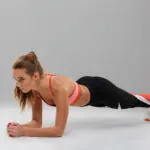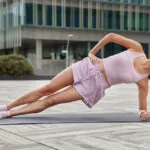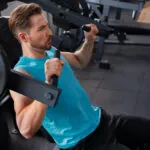Whether you’re aiming to enhance strength, boost flexibility, or sculpt your lower body, this exercise offers extensive benefits. However, like any sophisticated fitness maneuver, precision is key. The purpose of this guide is to navigate you through common pitfalls and ensure you reap maximum gains from your efforts, all while maintaining safety and efficiency.
Kettlebell exercises are renowned for their ability to provide a comprehensive workout that combines strength, balance, and endurance training. When performed correctly, the Bulgarian split squat specifically targets your quads, hamstrings, glutes, and calves, while also engaging your core and stabilizers for improved overall functionality.
Common mistakes
Let’s take a look at a few things you should pay attention to:
Incorrect foot placement
A frequent misstep is improper foot placement, which can lead to imbalances and reduced effectiveness of the exercise. Placing your front foot too close or too far from your body can strain your knees and hips, making the workout less effective and increasing the risk of injury.
Begin by ensuring your front foot is firmly planted about two feet in front of your bench or step. Your rear foot should be elevated on the bench, with the top of your foot resting against it. This positioning allows for greater stability and depth while preventing undue stress on your knee.
Kettlebell handling errors
Handling the kettlebell improperly is another common error. Some lifters hold the kettlebell too loosely, while others grip it too tightly, causing unnecessary fatigue or discomfort. Moreover, incorrect kettlebell placement can shift the focus from the target muscle groups, reducing the effectiveness of the exercise.
Hold the kettlebell in the goblet position close to your chest. This position helps maintain balance and encourages proper posture throughout the exercise. Ensure a firm but comfortable grip to control the kettlebell’s movement effectively.
Poor body alignment
Misalignment of the spine, hips, or shoulders can not only diminish the benefits of your workout but also pose serious risks to your joints and muscles. Ensuring proper alignment is crucial to performing this exercise effectively and safely.
Keep your spine neutral and hips squared throughout the motion. Avoid leaning forward or letting your hips sag. Imagine a straight line running from your head through your back to your elevated heel, and maintain this posture as you lower yourself.
Inadequate depth
Achieving the right depth in the squat is essential for activating the correct muscle groups. A shallow squat will not sufficiently challenge your muscles, while too deep a squat could compromise your form, especially if your flexibility and strength levels do not support it.
Lower yourself until your thigh is parallel to the floor, ensuring your front knee does not extend beyond your toes. Adjust your stance width if you find maintaining balance challenging or if you feel strain in your knees.
Excessive speed
Rushing through the movements can lead to a lack of control and an increased risk of injury. It’s important to maintain a pace that allows you to manage the weight and execute each phase of the exercise with control.
Execute each repetition slowly and with control, particularly as you lower yourself into the squat. Use a two-second count to descend, pause briefly at the bottom, and use your core and leg strength to return to the starting position smoothly.
Another important unilateral exercise you want to avoid doing incorrectly is kettlebell rows. See the common mistakes and how to correct them.
If you need more tips to improve your form overall, get in touch with our personal trainers in Lake City.
Final thoughts
As you continue to integrate this exercise into your workout regimen, keep in mind that progress comes with patience and consistent practice. Paying close attention to your form and making necessary adjustments based on the techniques we’ve discussed will help you avoid injuries and maximize the effectiveness of your workouts. Don’t rush the process—embrace it. Each session is an opportunity to get better.





